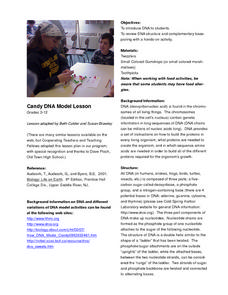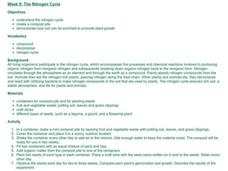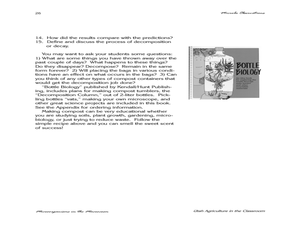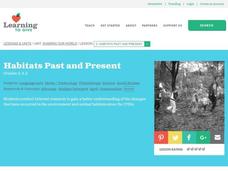Curated OER
Introduction to Biology
Students participate in a variety of activities to introduce them to biology. In this biology lesson plan, students use microscopes, discover bacteria, view human anatomy, and more.
Curated OER
Forest Food Web
Students explore the elements of a forest ecosystem. They examine the elements needed to form a forest food web. Students construct and describe food webs that include nonliving elements of the ecosystem.
Curated OER
What If We Run Out?
Students explore the consequences of shrinking habitats and the human impact on wildlife populations. They participate in a game to study the consequences and describe the preservation of animal habitats.
Curated OER
Oceans and Weather
Pupils analyze the impact the ocean and its currents have on weather. In this oceans and weather lesson, students analyze data comparing inland and coastal weather, and analyze satellite data for evidence of El Nino.
Curated OER
Working on the Moon
Students take a mission to the moon. In this space science instructional activity, students visit selected websites to discover information about Earth's moon and the solar system. Students may take virtual missions to the moon...
Curated OER
Connect the Species
Fourth graders, in pairs, explore energy transfer and species interrelationships by viewing slides on a microscope. hey explore phytoplankton (producers) and zooplankton (consumers)
Curated OER
Candy DNA Model Lesson
Young scholars explore DNA structure using materials such as Twizzlers, small colored gumdrops and/or toothpicks.
Curated OER
The Nitrogen Cycle
Students design and create a compost pile in order to study the Nitrogen Cycle. They then use the scientific method to determine if plants grow better when they add organic matter from their compost pile to the plant's soil.
Curated OER
The Many, Varied, and Unusual Places and Things on Earth
Students discover how energy flows through communities because of the relationship between producers, consumers and decomposers. Examining various ecosystems, they identify the materials that cycle continuously through them. They label...
Curated OER
Clay Hill Animal Sampling
Students create animal print casts from molds in the classroom. They use the cast patterns to identify animal prints on a field trip in which they locate animal tracks, identify the location with GPS and create field casts of the...
Curated OER
Earth: The Apple of our Eye
Students are led through a demonstration in which they cut open an apple, which represents the earth. They follow through the hands-on activity, cutting the apple into various portions--each representing some aspect of the earth.
Curated OER
Eco-Warrior
Students recognize that a man's actions in changing his environment can have drastic results for their world. They discuss the use of energy conservation and the use of recycling materials to improve our environment.
Curated OER
Epidemic, Plague, and Infection
Pupils investigate the illness borne in concentration camps. In this Holocaust lesson, students participate in a simulation that requires them to consider how ailments became epidemics in concentration camps.
Curated OER
Rotten Truth
Pupils complete activities to study decomposition. For this decomposition lesson, students work in pairs to observe a decay buffet experiment. Pupils keep compost bag journals. Students define and discuss the process of decomposition.
Curated OER
Plate and Planet
Students investigate the health hazards of modern agriculture and how we can choose better food options. In this healthy eating lesson, students identify different indigenous people in photographs and discuss what they might eat....
Curated OER
Birds: Wetlands Ecosystems
In this birds worksheet, students click on the links to learn about the birds of the Wetlands and answer short answer questions about it. Students complete 7 questions total.
Curated OER
Bivalve or Univalve (Clam or Snail)?
Fourth graders explore the meaning of the prefixes "bi" and "uni." In groups, 4th graders observe pictures of shells and handle real shells. Students create a chart to classify each shell as a bivalve or univalve. They identify the...
Curated OER
The Galapagos Islands
In this The Galapagos Islands worksheet, learners read a 1 page article, answer 3 statements with multiple choice answers, fill in 4 fill in the blank answers and 3 determine if 3 statements are true or false.
Curated OER
Radical Reptiles
In this reptiles learning exercise, learners read about reptiles and then answer 10 questions about what they just learned. The answers are on the last page.
Curated OER
Habitats Past and Present
Students explore the changes in animal habitats. In this ecosystem lesson plan, students use the Internet to explore the changes in the environment since the 1700's. Students complete a Venn diagram to compare the differences in the...
Curated OER
Seabird Survival Adaptation Card Game
Students study seabirds and how they have adapted to their environments. In this activity based instructional activity students will play a card game that will allow them to have a better understanding of seabirds and their...
Curated OER
Build a Reef
Students build a coral reef, then discover organisms that make up the ecosystem.
Curated OER
The Tides
Students experience a computer based applet that explains why the Earth experiences tides.
Curated OER
Illnois River and Lake Mussel Habitat Diorama Activity
Students identify the environmental elements of river and lake mussels. They compare the elements to the time before settlement and during industrialization. They also participate in a field trip to a mussel exhibit.























